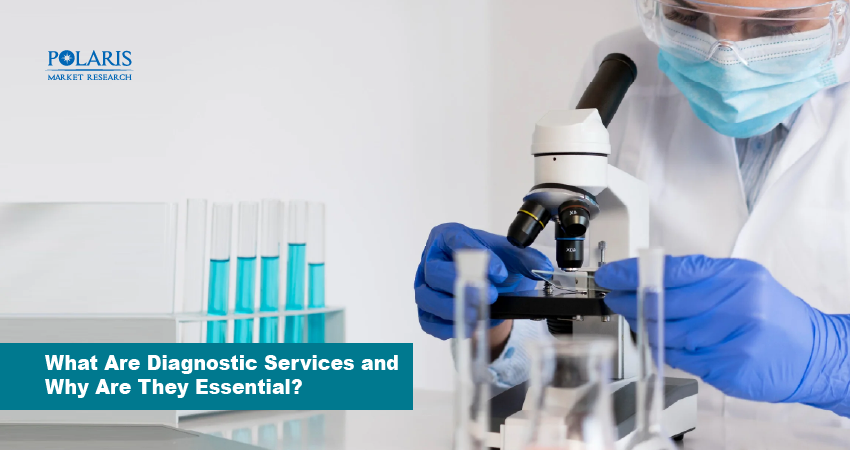What Are Diagnostic Services and Why Are They Essential?

Diagnostics is a highly important tool in healthcare. It enables the health workforce to identify diseases or health conditions. Treatment initiation is also facilitated to prevent further complications and costly treatments. Diagnostic services are vital to prevent, screen, and diagnose disabilities, diseases, and injuries.
Want to know more about what’s covered under diagnostic services and why they are needed? In this blog post, we explain to you the fundamentals of these services. We also cover the major metrics for the diagnostics services market and detail how artificial intelligence (AI) is changing the market landscape. Let’s dive in!
Diagnostic Services: Introduction
Diagnostic services are a key component of modern healthcare. They include the imaging scans and medical tests needed for identifying diseases and determining their level of severity. Other procedures that help identify diseases are also a part of diagnostic services. Using diagnostic services, patients can accurately diagnose their health conditions. It also allows them to prescribe appropriate treatments.
The role of diagnostic services is vast. It also varies slightly across different fields of medicine. A key function of these services is to enable doctors to make informed decisions. By analyzing data from lab results and tests, doctors can get a better understanding of what’s actually going on inside the body.
Diagnostic services are also important for preventive medicine. They help in identifying the risk of chronic conditions early on. This enables physicians to have early interventions and prevent the progression of the disease. Furthermore, these services offer crucial insights into an individual’s health conditions that go beyond basic symptoms.
Diagnostic Services Market Metrics
Our latest analysis reveals the diagnostic services market to register significant growth. The market was valued at USD 1,178.28 billion in 2024. It is projected to grow at a CAGR of 13.03% from 2025 to 2034.
Growing technological advancements in magnetic resonance imaging (MRI) modeling are driving market expansion. The market is also benefiting from rising product launches for advanced diagnostic testing services.
Types of Diagnostic Services
Pathology
A pathology is a clinical facility where tests on clinical specimens are carried out. This information is used to identify any diseases or health issues the patient may have. Pathology tests typically involve assessing fluids and tissues from the body. The results from these tests help doctors in diagnosing and treating patients correctly.
Digital X-Ray
Digital X-ray is an advanced form of X-ray inspection. It produces a digital image instantly on the computer. It makes use of X-ray sensitive plates for capturing information during the examination of the object. The information is then instantly transferred to the computer. Digital X-ray doesn’t need the use of an intermediate cassette. In digital X-rays, the conversion of the incident X-ray radiation into an equivalent electric charge first takes place. A detector sensor is then used for converting the electric charge into a digital image. The digital X-ray market offers both fixed and portable X-rays for varying needs.
Sonography
Sonography also goes by the name ultrasound. It makes use of high-frequency sound waves. These waves capture real-time images or videos of tissues and various organs inside the body. With ultrasound, healthcare providers can see details about soft body tissues without needing to make cuts. Sonography also doesn’t make use of radiation. The diagnostic imaging procedure is typically associated with pregnancy. However, healthcare providers can use it for assessing various situations.
Stress (TMT) test
This is a commonly used test to know how well blood is pumped by the patient’s heart. It also helps assess whether the patient's heart is receiving an adequate supply of blood and how well they perform during physical activity. The test involves calling the person to walk on a treadmill.
2D Echo
A 2D echo test makes use of ultrasound waves for assessing heart functioning. The test generates a moving picture of the heart and the valves. This gives the doctor a clear view of the structure and function of the heart. There are various types of 2D echo tests. These include transthoracic echocardiogram (TTE) and transesophageal echocardiogram (TEE), amongst others. The specific test type is chosen based on the exact needs of the patient.
CT Scan
A CT scan makes use of X-ray techniques for creating detailed images of the body. A computer is then used for creating cross-sectional images of the soft tissues, blood vessels, and bones. CT scan images are more detailed than normal X-rays. There are various uses of CT scan images. It can be used for diagnosing a disease or injury. Solutions from the CT scanner market may also help with planning medical or radiation treatment.
Benefits of Diagnostic Services
Diagnostic services offer timely diagnosis of illnesses and medical conditions. A key benefit is that they enable the identification of medical conditions early on. This helps in the quick initiation of treatment and better outcomes. Another benefit of diagnostic services is that they offer valuable information about the overall health of the patient. This information helps doctors in making informed decisions about treatment plans.
Diagnostic services also help in reducing healthcare costs. It does so by avoiding treatments that aren’t needed. The identification of specific conditions through testing also assists in avoiding prescribing medications or having expensive lab work that isn’t needed.
AI and Diagnostic Services Market
The use of AI helps with the quick interpretation of medical images and lab test results. This improves the efficiency of diagnostics. AI-enabled predictive models help in the early detection of diseases. The automation of daily tasks by AI reduces operational costs. AI also plays an important role in remote diagnostics and the provision of telehealth services.
To Conclude
Diagnostic services are essential for today’s healthcare. These services ensure the provision of timely and cost-effective diagnostic care. They can also help with treatment outcomes by identifying diseases when they are in their early stages. The diagnostic services market will continue to expand as both public and private players continue to invest in diagnostic services.

